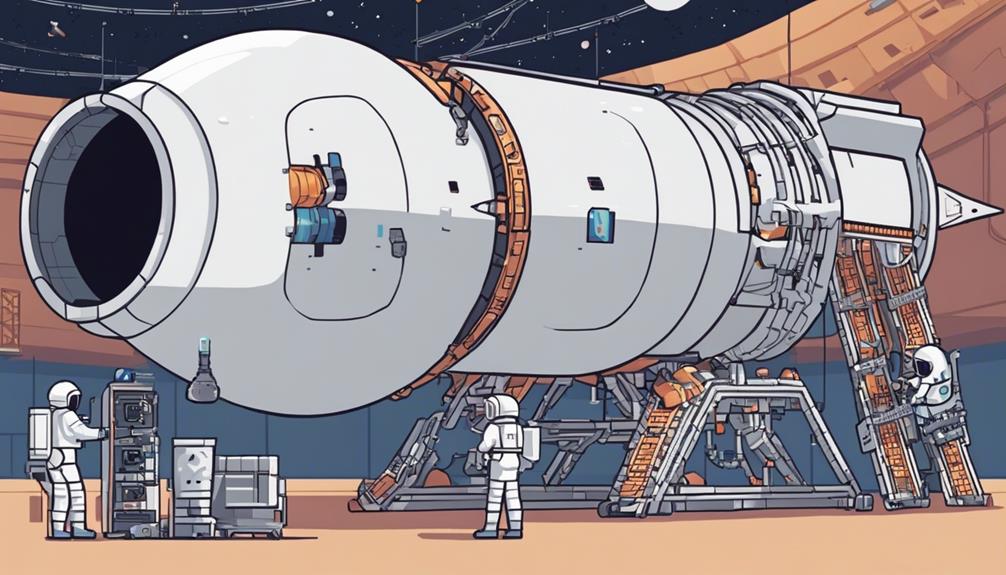The intricate process of preparing a SpaceX satellite launch is a symphony of precision and expertise. From the meticulous vehicle assembly to the critical payload integration and propellant loading, each step is a testament to careful planning and execution. As the countdown progresses through pre-launch checks and weather monitoring, the culmination of these efforts leads to a momentous event. However, the journey doesn't end there; communication setup, navigation calibration, and system testing pave the way for a successful mission. The complexities of this process highlight the dedication and innovation that drive the aerospace industry forward.
Key Takeaways
- Vehicle assembly integrates satellite payload with Falcon 9 rocket for launch.
- Thorough safety checks and system testing ensure optimal spacecraft performance.
- Weather monitoring and safety protocols dictate launch readiness and potential rescheduling.
- Payload integration and deployment processes ensure successful mission objectives.
Vehicle Assembly

The process of assembling the vehicle for a SpaceX satellite launch involves the meticulous integration of the satellite payload with the Falcon 9 rocket at the designated launch site. SpaceX technicians undertake a methodical approach to prepare both the satellite and rocket components for mating in a controlled environment. This preparation includes careful alignment and testing of all systems to ensure proper integration and functionality before the launch.
One crucial step in this process is encapsulating the satellite within the Falcon 9 rocket's payload fairing. This fairing serves the dual purpose of protecting the satellite during the ascent phase of the launch and ensuring a successful deployment once in space.
Throughout the vehicle assembly operations, precision and attention to detail are paramount. Every aspect of the integration process is meticulously managed to guarantee a safe and reliable launch for the satellite mission. The Falcon 9 rocket, known for its reliability and versatility, plays a central role in this process, providing the necessary thrust and payload capacity to deliver the satellite to its intended orbit. SpaceX's commitment to excellence in vehicle assembly is evident in the stringent quality control measures implemented at every stage of the integration process.
Payload Integration
During the payload integration phase, rigorous safety checks are conducted to ensure the secure attachment of the satellite to the launch vehicle. Engineers meticulously verify the alignment and connection of the payload to the rocket to guarantee a successful mission. Additionally, payload fairings are essential components that safeguard the satellite during ascent and are later discarded in space.
Payload Safety Checks
Specialists meticulously conduct safety checks during the payload integration process to ensure the secure attachment of the satellite to the rocket for launch.
- Detailed Inspections: Specialists meticulously inspect the attachment points to verify the secure connection between the satellite and the rocket.
- Structural Integrity: Checks are performed to confirm the structural integrity of the payload and its compatibility with the rocket.
- Functional Testing: Functional tests are carried out to ensure the payload systems are operational and ready for the space environment.
- Contingency Planning: Integration teams establish contingency plans to address any potential issues that may arise during the payload safety checks to mitigate risks.
Integration Process Overview
Amidst the intricate preparations for a SpaceX satellite launch, the integration process overview delves into the meticulous assembly of the satellite payload with the rocket at the launch site. Specialized engineers and technicians play a crucial role in carefully attaching the satellite payload to the rocket's payload adapter, ensuring proper alignment, electrical connections, and structural integrity. Post-integration, extensive testing and verification procedures are conducted to confirm the satellite's readiness for the upcoming SpaceX launch. This critical step in the launch process demands precision and attention to detail to guarantee mission success. The integration process is a key phase where the satellite becomes an integral part of the rocket, setting the stage for a successful deployment into orbit.
Propellant Loading

Propellant loading during a SpaceX satellite launch is a meticulously planned process that involves stringent safety measures and precise sequencing of steps. Ensuring the correct balance of supercooled liquid oxygen and rocket-grade kerosene is essential for optimizing performance. Ground crews, engineers, and launch controllers work in tandem to guarantee the efficient transfer of propellants, emphasizing safety and operational excellence.
Propellant Safety Measures
During the propellant loading phase of preparing for a SpaceX satellite launch, meticulous care is taken to load the Falcon 9 rocket with RP-1 fuel and liquid oxygen, essential components for optimal rocket performance during liftoff and ascent.
- Safety Protocols: Strict safety protocols are followed to prevent accidents or mishaps during the propellant loading process.
- Monitoring Systems: Advanced monitoring systems are utilized to track the temperature, pressure, and flow rate of the RP-1 fuel and liquid oxygen during loading.
- Emergency Procedures: Comprehensive emergency procedures are in place to address any unforeseen issues that may arise during the propellant loading operation.
- Quality Control: Stringent quality control measures are implemented to ensure the purity and integrity of the RP-1 fuel and liquid oxygen before loading into the Falcon 9 rocket.
Loading Sequence Steps
In the meticulous process of preparing for a SpaceX satellite launch, the loading sequence steps for propellant loading play a crucial role in ensuring the optimal performance and safety of the Falcon 9 rocket. Propellant loading at the Space Launch Complex occurs in the final hours leading up to liftoff, involving the precise loading of rocket-grade kerosene (RP-1) as fuel and liquid oxygen (LOX) as the oxidizer into the Falcon 9's tanks. This process is meticulously monitored and controlled to guarantee accurate quantities and safe handling of the propellants. Once the propellant loading is complete, the Falcon 9 rocket is fully fueled and prepared for launch, ready to propel the satellite into orbit with precision and efficiency.
Pre-Launch Checks
Conducting thorough pre-launch checks is a critical step in preparing for a successful SpaceX satellite launch. These checks are essential to ensure that all systems and components of the spacecraft are functioning optimally and are ready for the demands of space travel. Here are four key aspects of pre-launch checks:
- Verification of Systems: Engineers meticulously inspect and verify the functionality of the spacecraft's electrical systems, propulsion systems, communication systems, and structural integrity. Each system must meet stringent criteria to proceed with the launch.
- Extensive Testing: Extensive testing is conducted to ensure that all systems are operating within specified parameters. This testing involves simulating various scenarios to assess the spacecraft's performance under different conditions.
- Data Analysis: Data collected during pre-launch checks are thoroughly analyzed to validate that the spacecraft is fully prepared for the challenges of both the launch itself and subsequent operations in space. Any anomalies or deviations from expected results are carefully reviewed and addressed.
- Risk Mitigation: Pre-launch checks play a crucial role in risk mitigation by identifying and resolving any potential issues before liftoff. This proactive approach helps to minimize the chances of in-flight complications and ensures a higher likelihood of mission success.
Weather Monitoring

Upon completion of the pre-launch checks, the next critical phase in preparing for a successful SpaceX satellite launch involves meticulous monitoring of weather conditions at the launch site, specifically Cape Canaveral Air Force Station. SpaceX monitors various weather parameters such as wind speed, cloud cover, and lightning activity to ensure safe launch conditions. Specific weather criteria must be met, including the absence of thunderstorms within a certain radius and acceptable wind speeds to maintain rocket stability during liftoff.
Meteorologists play a vital role in providing real-time updates on weather patterns and potential hazards that could impact the launch window. To gather precise data on atmospheric conditions at different altitudes, weather balloons are released, aiding in making informed decisions regarding the launch. This continuous monitoring extends up to the final minutes before liftoff, with meteorologists offering the latest weather briefings to the launch team. Based on this information, a definitive 'go' or 'no go' decision is made to proceed with the launch.
The comprehensive weather monitoring process at Cape Canaveral Air Force Station ensures that all necessary precautions are taken to mitigate weather-related risks and maximize the chances of a successful SpaceX satellite launch.
Final Countdown
As the final countdown commences, the launch team conducts thorough checks on the launch pad systems to ensure readiness for liftoff. SpaceX's meticulous procedures involve ensuring all systems are functioning correctly before the rocket is made vertical on the pad. The team's focus intensifies as they await the critical T-Zero moment to initiate the precise sequence leading to launch.
Launch Pad Check
During the final countdown for a SpaceX satellite launch, meticulous checks and verifications are conducted at the launch pad to ensure all systems are operating optimally for liftoff.
- System Verifications: Engineers double-check all onboard systems, from propulsion to communication, to confirm readiness.
- Fueling Operations: The rocket is fueled with the necessary propellants according to the mission requirements.
- Power-Up Tests: Critical tests are performed to ensure electrical systems are functioning correctly.
- Final Configurations: Last-minute adjustments and configurations are made to align the rocket for a successful launch.
These processes are essential for ensuring that the spacecraft is in prime condition for its journey into space.
Systems Go!
Following the meticulous checks and verifications conducted at the launch pad during the final countdown, the SpaceX team ensures that all systems are 'go' as they prepare to make the rocket vertical for liftoff. The final countdown moment, known as T-Zero, marks the culmination of extensive launch preparations. Launch Operations Management involves meticulous data analysis, confirmation of readiness, and precise coordination among the team members. The partnership between SpaceX, NASA, Orbital ATK, and MIT plays a pivotal role in managing the final countdown and ensuring seamless launch operations. This collaborative effort guarantees that all systems are functioning optimally, meeting the stringent requirements for a successful satellite launch.
| Systems Go! | Details | Importance |
|---|---|---|
| Final Checks | Verifying all systems before liftoff | Ensures Safety |
| T-Zero Moment | The final countdown moment for liftoff | Critical Timing |
| Launch Operations Mgmt | Data analysis, readiness confirmation, coordination | Operational Efficiency |
| SpaceX Partnership | Collaborating with NASA, Orbital ATK, and MIT | Strategic Alliance |
| System Functionality | Ensuring optimal performance of all systems | Mission Success |
Liftoff

Initiating the launch sequence, SpaceX's Falcon 9 rocket propels skyward from Cape Canaveral Air Force Station in Florida to commence the deployment of a satellite into orbit. During the liftoff phase:
- First Stage Ascent: The Falcon 9 rocket's initial ascent is powered by its first stage, equipped with nine SpaceX Merlin 1C rocket engines. These engines work in unison to propel the rocket upwards, overcoming Earth's gravity.
- First Stage Cutoff: Approximately 180 seconds into the flight, the Falcon 9's first stage engines cut off, signifying the end of their task. This event marks the transition to the next phase of the launch.
- Stage Separation: Following the first stage cutoff, stage separation occurs. The first stage separates from the second stage, which then ignites its engines to continue the journey towards orbit.
- Satellite Deployment: Around 9 minutes into the flight, the satellite separates from Falcon 9's second stage. This critical moment allows the satellite to enter its designated orbit and begin its mission in space.
The liftoff phase of a SpaceX satellite launch is a meticulously orchestrated series of events that must unfold flawlessly to ensure the satellite's successful deployment into orbit. The transition from liftoff to stage separation marks a crucial step in the journey towards achieving operational orbit for the satellite.
Stage Separation
Upon reaching approximately 180 seconds into the flight of a SpaceX satellite launch, an essential event known as stage separation takes place. During this phase, the Falcon 9's first stage engines cut off, signifying the transition from the initial phase of flight to the subsequent stage. The first stage, having fulfilled its purpose, disengages from the rest of the rocket, enabling the second stage engines to ignite and propel the vehicle further towards its intended orbit.
This meticulously orchestrated process is critical for the success of the mission, ensuring a smooth handover between the stages of the launch. As the first stage drops off, the second stage seamlessly takes over, continuing the journey with the payload onboard, be it the Dragon capsule or another satellite. The separation of the stages marks a pivotal moment in the mission timeline, as it signifies the shift in responsibilities from the first stage to the second stage, which must now carry the payload the rest of the way to its designated orbit.
Once the separation is complete, the second stage assumes full control, guiding the payload towards its intended destination with precision and accuracy. This carefully timed and coordinated stage separation process is a testament to the advanced engineering and planning that underpin every SpaceX satellite launch.
Payload Deployment

Payload deployment during a Falcon 9 rocket launch typically occurs approximately 9 minutes into the mission. This phase marks a critical moment in the satellite deployment process, ensuring the payload is released successfully for its journey into orbit. The deployment sequence involves a series of precise steps to guarantee the satellite's safe transition into space.
Key Steps in Payload Deployment:
- Separation of the Dragon Capsule: As the Falcon 9 ascends, the Dragon capsule separates from the rocket's second stage. This separation is a crucial initial step in preparing the payload for deployment.
- Solar Array Deployment: Following separation, the Dragon capsule deploys its solar arrays. These arrays are essential for generating power that sustains the satellite's operations throughout its mission.
- Activation of Maneuvering Thrusters: Post-deployment, maneuvering thrusters onboard the Dragon capsule are activated. These thrusters enable the capsule to make any necessary trajectory adjustments, ensuring it heads towards its designated orbit accurately.
- Importance of Successful Deployment: The successful deployment of the payload is paramount for the satellite's continued journey towards its intended orbit. Any issues during this phase can significantly impact the mission's success and the satellite's operational capabilities.
Ensuring each of these steps is executed flawlessly is crucial in guaranteeing the satellite's successful deployment and the commencement of its operational duties in space.
Orbit Insertion
Upon separation, the Dragon capsule engages its thrusters to execute precise trajectory adjustments for optimal orbit insertion. This process involves calculated engine firings to attain the desired altitude and orbital inclination. Orbit insertion marks a pivotal stage necessitating meticulous monitoring by SpaceX's mission control to ensure alignment with mission parameters.
Trajectory Adjustment
During a SpaceX satellite launch, one of the critical post-separation procedures is the precise trajectory adjustment, also known as orbit insertion, conducted to accurately position the satellite in its designated orbit around Earth.
- The second stage engines ignite to ensure the satellite reaches its intended orbit.
- Engineers meticulously calculate the trajectory adjustment for optimal positioning.
- Achieving the correct orbital parameters like altitude, inclination, and eccentricity is essential.
- Trajectory adjustment is vital for maximizing the satellite's performance and functionality over its operational lifespan.
Engine Firing
The critical phase of engine firing, essential for the successful orbit insertion of the satellite, involves the precise ignition of Falcon 9's second stage engines. After the first stage separation, typically occurring around 180 seconds into the flight, the second stage engines take over to propel the spacecraft towards its designated orbit. These engines provide the necessary thrust to achieve the required velocity, enabling the payload to reach its intended orbital position. Precision in engine firing is paramount as it directly impacts the spacecraft's ability to reach the correct orbital parameters for its mission. This phase of engine firing during orbit insertion is a crucial step that demands accuracy and reliability for the successful launch of the satellite.
| Engine Firing: | ||
|---|---|---|
| Key Aspect | Description | Importance |
| Ignition | Precise start of engines | Ensures proper thrust |
| Timing | After first stage separation | Critical for trajectory |
| Thrust | Provides necessary velocity | Crucial for orbit |
In-Orbit Operations

In preparation for a successful SpaceX satellite launch, the in-orbit operations encompass critical system checkouts and maneuvers conducted by the Dragon capsule to ensure operational readiness for its rendezvous with the International Space Station. During this phase, several key activities take place:
- System Checkouts: The Dragon capsule meticulously examines all its functions to verify their operational status. This ensures that all systems and payloads are functioning as intended before the capsule approaches the ISS.
- Solar Array Deployment: To power its systems and payloads, the Dragon capsule deploys its solar arrays. These arrays harness solar energy, providing the necessary power for the capsule's operations in orbit.
- Fly-Under Demonstration: On the third day in orbit, the Dragon capsule performs a fly-under maneuver of the ISS. This maneuver showcases the capsule's maneuvering capabilities and operational readiness for its rendezvous with the space station.
- Communication Setup: Utilizing the COTS Ultra-high frequency Communication Unit, the Dragon capsule establishes communication with the ISS during the fly-under. This communication link is vital for coordination and data exchange between the two spacecraft, enabling a safe and successful approach.
Throughout these in-orbit operations, the crew onboard the ISS actively monitors Dragon's approach and fly-under, ensuring the safety and integrity of operations between the capsule and the space station.
Communication Setup
Facilitating seamless data transmission and reception, the communication setup for SpaceX satellites integrates ground-based antennas and satellite-to-satellite links. SpaceX satellites establish communication with ground stations through a network of strategically positioned antennas that provide global coverage. These ground-based antennas are crucial for relaying commands to the satellites and receiving telemetry data. Additionally, satellite-to-satellite links enable direct communication between SpaceX satellites, enhancing data transfer efficiency and reducing reliance on ground stations.
The communication setup involves configuring various parameters such as frequency bands, signal strength, and encryption protocols to ensure secure and reliable data transmission. Prior to launch, extensive testing is conducted during simulations to validate the communication protocols and verify seamless data transfer capabilities. This meticulous testing process helps mitigate any potential communication issues that may arise during the mission.
During the mission, SpaceX employs advanced tracking and telemetry systems to monitor the health, performance, and orbital parameters of the satellites in real-time. These systems provide essential data to mission control, enabling engineers to make informed decisions and adjustments as needed. The robust communication setup plays a critical role in ensuring the success of SpaceX satellite missions by enabling continuous and reliable data exchange between the satellites and ground stations.
Navigation Calibration

To ensure optimal performance and accuracy in space, navigation calibration for SpaceX satellites entails meticulous fine-tuning of onboard sensors and instruments for precise positioning and orientation.
- Sensor Adjustment: Calibration procedures involve adjusting gyroscopes to maintain the satellite's stability and orientation in space.
- Accelerometer Calibration: Fine-tuning accelerometers is crucial for accurately measuring the satellite's acceleration and velocity during maneuvers.
- Star Tracker Alignment: Aligning star trackers is essential for determining the satellite's attitude and position relative to distant stars for navigation accuracy.
- GPS System Calibration: Calibrating the GPS system ensures that the satellite can accurately determine its position and adjust its trajectory as needed.
Ground control teams play a vital role in overseeing the navigation calibration process. They monitor and analyze calibration data to verify that the satellite's navigation systems are operating within specified parameters. This meticulous calibration is particularly critical for guiding the satellite during pivotal maneuvers like orbital insertion, station-keeping, and attitude control. By achieving precise navigation calibration, SpaceX satellites enhance their capability to fulfill mission objectives with precision, whether it be accurate orbital placement or precise target tracking in space environments.
Solar Panel Deployment
Following separation from the Falcon 9 rocket's second stage, the Dragon capsule deploys its solar panels to provide essential power for its journey to the International Space Station. The solar panels play a critical role in sustaining the capsule's energy supply throughout its mission. Designed to efficiently capture sunlight in the space environment, these panels are vital for generating the electricity needed to power the various systems onboard the Dragon capsule.
The deployment of the solar panels is a meticulously planned procedure, ensuring that they unfurl correctly to start harnessing solar energy efficiently. This step is crucial for the autonomous operation of the Dragon capsule in orbit, as it relies on these panels to convert sunlight into electrical power to support its functions and equipment.
The solar panel deployment showcases the advanced technological capabilities integrated into the Dragon capsule, allowing it to operate independently in the harsh conditions of space. With a focus on precision and reliability, SpaceX ensures that the solar panels are a robust component of the capsule's power system, enabling it to successfully navigate its journey to the International Space Station and fulfill its mission objectives.
System Testing

After the successful deployment of the solar panels, the next critical phase in preparing for a SpaceX satellite launch is conducting comprehensive system testing. System testing involves rigorous evaluations of satellite components and systems to ensure they function correctly in space. To achieve this, several key steps are undertaken:
- Thermal Vacuum Tests: These tests simulate the harsh conditions of space, subjecting the satellite to extreme temperatures and vacuum environments to assess its performance in such settings.
- Vibration Tests: Mimicking the stresses experienced during launch, vibration tests are conducted to ensure the satellite can withstand the mechanical vibrations and shocks it will encounter.
- Electromagnetic Compatibility Checks: By assessing electromagnetic interference, these checks verify that the satellite's systems can operate without disruptions from electromagnetic fields in space.
- Integration Tests: Engineers perform integration tests to confirm that all satellite subsystems work harmoniously together. This verification ensures that communication systems, power management, navigation equipment, and other components function seamlessly as a unified system before the satellite is launched.
System testing is crucial as it helps detect and rectify any potential issues or malfunctions that could compromise the success of the satellite mission, ensuring that the satellite is fully operational and reliable in its intended space environment.
Frequently Asked Questions
What Are the Stages of a Spacex Launch?
The stages of a SpaceX launch involve liftoff using Falcon 9 rocket fueled by rocket fuel. Key events include liftoff, Main Engine Cut Off, Stage Separation, second stage engine ignition for orbital insertion, and payload separation. These meticulously orchestrated stages ensure the successful delivery of the payload to its intended orbit. Each phase is crucial for the overall success of the mission, demonstrating the precision and technical expertise involved in SpaceX launches.
What Is the Process of Spacecraft Launch?
In the process of spacecraft launch, Mission Control plays a pivotal role in overseeing and coordinating all aspects of the mission. This includes monitoring pre-launch preparations, communicating with the spacecraft during ascent, and ensuring the successful deployment of the payload into orbit. Mission Control teams are responsible for making critical decisions in real-time, managing any anomalies that may arise, and ultimately ensuring the mission's success through meticulous planning and execution.
What Are the Stages of a Satellite Launch?
The stages of a satellite launch involve liftoff, main engine cut off (MECO), stage separation, payload separation, and orbital operations. Orbital mechanics play a crucial role in determining the trajectory and positioning of the satellite in space. Liftoff is powered by Falcon 9's first stage, while MECO occurs around 180 seconds into the flight. Following MECO, stage separation takes place, leading to the separation of the payload from the rocket's second stage.
How Do They Launch the Spacex Rocket?
Launching a SpaceX rocket involves a meticulously orchestrated process that begins with fueling the rocket tanks with a precise blend of rocket fuel. The rocket's engines ignite, propelling the vehicle skyward with the power of a roaring beast. The controlled burn of the rocket fuel generates thrust, lifting the spacecraft towards its designated orbit with precision and efficiency.

